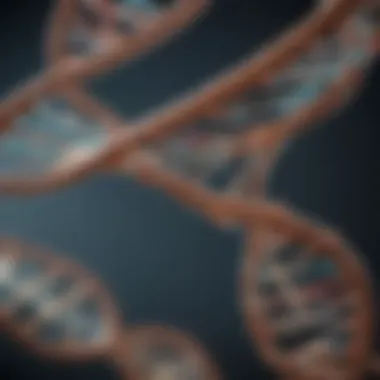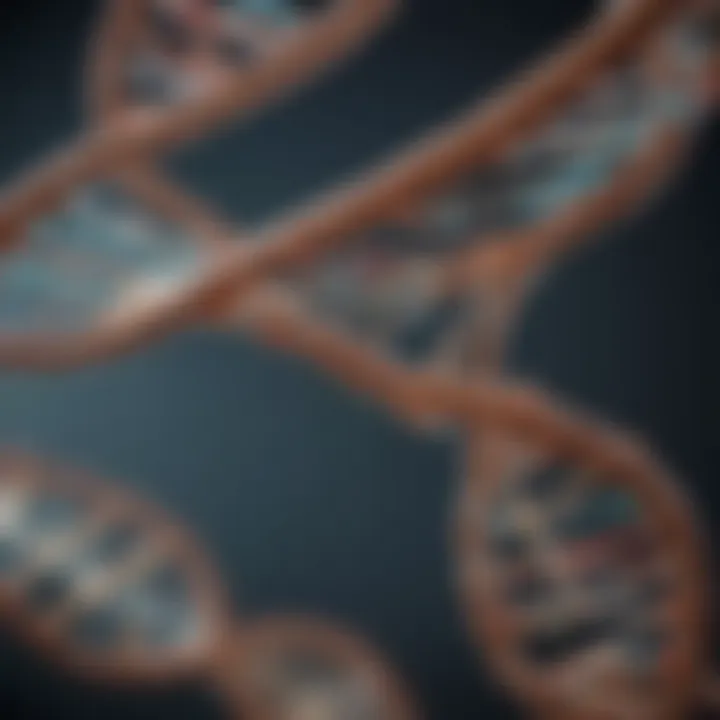How to Conduct a DNA Test: Step-by-Step Guide


Intro
In today's world, DNA testing has become a pivotal tool across various fields. From ancestry tracing to medical diagnostics, understanding how to perform a DNA test is essential. This guide seeks to unravel the complexities behind DNA testing, making it accessible for those interested in the subject, regardless of their experience.
Article Overview
Purpose of the Article
This article aims to provide a clear and detailed approach to conducting a DNA test. It highlights the critical steps involved, ensuring that readers grasp the entire process—from sample collection to result interpretation. By illuminating the significance of accurate methodology, we hope to foster an understanding of what DNA tests can reveal.
Relevance to Multiple Disciplines
DNA testing has applications in various domains, including:
- Ancestry Exploration: Understanding genetic heritage and family connections.
- Forensic Science: Assisting in criminal investigations through genetic evidence.
- Medical Applications: Diagnosing genetic disorders and personalizing healthcare.
The relevance of DNA testing extends beyond mere curiosity. It intersects with genetics, law, medicine, and social science, establishing a foundation for interdisciplinary research and discussions.
Research Background
Historical Context
The exploration of DNA began in the mid-20th century. The discovery of the DNA double helix structure by James Watson and Francis Crick in 1953 laid the groundwork for modern genetic research. Since then, advancements in technology have made DNA testing more accessible and accurate, enabling its wide application in various fields.
Key Concepts and Definitions
To understand DNA testing, one must grasp some fundamental concepts:
- DNA (Deoxyribonucleic Acid): The hereditary material in humans and most organisms.
- Genotype: The genetic constitution of an individual organism.
- Phenotype: The observable physical or physiological traits of an organism.
These terms serve as a basis for understanding various DNA tests, whether they are focused on ancestry, medical conditions, or forensic analysis.
Prelude to DNA Testing
DNA testing is a vital process that has become increasingly popular in various fields, such as medical diagnostics, ancestry research, and forensic science. Understanding what DNA testing entails is fundamental for anyone interested in utilizing this tool for personal or professional purposes. DNA, or deoxyribonucleic acid, holds the genetic blueprint of an individual. Its analysis can yield profound insights about a person's ancestry, health conditions, and even illicit activities.
Definition of DNA Testing
DNA testing refers to the methods used to analyze genetic material to obtain information about an individual’s genetic makeup. This can involve identifying specific sequences in the DNA that can lead to various conclusions about health, family lineage, or criminal investigations. In essence, DNA serves as a personal fingerprint unique to each individual, making it an invaluable asset in scientific inquiry.
Purpose and Applications
DNA testing serves multiple purposes, catering to a wide range of applications. Here are some of the primary areas where DNA testing is applied:
Ancestry and genealogy
Ancestry and genealogy are among the most sought-after applications of DNA testing. Individuals often wish to learn about their lineage and cultural backgrounds. This process involves examining genetic markers that are passed down through generations, allowing people to trace their ancestry accurately. Key characteristics of this type of testing include its accessibility and the growing popularity of direct-to-consumer testing kits.
The significant advantage of using DNA for ancestry research is its accuracy compared to traditional methods, such as family trees. However, one must consider that results can sometimes be unexpected, revealing surprises that may not align with family narratives, which could lead to emotional challenges.
Medical diagnostics
Medical diagnostics utilize DNA testing to identify genetic conditions or predispositions to diseases. This aspect aims to provide critical information that can influence a patient's health management and care. A key characteristic of this application is its capacity for early detection of potentially life-threatening conditions.
The main benefit of medical genetic testing lies in personalized medicine, enabling tailored treatment plans based on an individual's specific genetic profile. Despite its benefits, there are limitations, including ethical concerns and the potential for psychological impacts of knowing one’s genetic risks.
Forensic analysis
Forensic analysis represents another crucial application of DNA testing. This field uses DNA evidence to solve crimes, identify victims, or exonerate individuals wrongfully accused. The main characteristics of forensic DNA testing include its high reliability and a well-established legal framework.
The advantage of using DNA in forensic settings is its ability to provide conclusive evidence that can significantly influence the outcomes of legal cases. However, the potential for errors in handling DNA samples or interpretations raises concerns about the integrity of the results.
Research purposes
Research purposes encompass a broad range of studies using DNA methods to advance scientific knowledge. This can include population genetics, evolutionary studies, and biomedical research. A unique feature of research-driven DNA tests is their capability to contribute to the understanding of genetic diseases, human evolution, and behavior.
The benefit here is the enhancement of public health and policy frameworks through collected data. However, ethical concerns regarding privacy and the use of genetic information remain a critical consideration in this field.


Understanding the various applications of DNA testing is essential for making informed decisions about its use in personal and professional contexts.
Understanding the various applications of DNA testing is essential for making informed decisions about its use in personal and professional contexts.
Types of DNA Tests
Understanding types of DNA tests is crucial in the realm of genetic testing. Each test serves a distinct purpose, providing insight into various aspects of an individual’s genetic makeup. The right type of test can illuminate family heritage, track inheritance patterns, or diagnose medical conditions. In contrast, using an inappropriate test might lead to misleading interpretations or unnecessary anxieties. Therefore, it is essential to delve into the differences among the main types of DNA tests available.
Autosomal DNA Testing
Autosomal DNA testing analyzes the 22 pairs of chromosomes that are not involved in determining sex. This type of testing is particularly effective for ancestry research. It can reveal heritage from both maternal and paternal lines. The results often provide ethnicity estimates and connect individuals to distant relatives. One of the key benefits of autosomal DNA tests is their ability to include both genders, making them accessible to everyone. Companies like AncestryDNA and 23andMe utilize this method, delivering detailed reports and potential family connections.
Y-DNA Testing
Y-DNA testing specifically examines the Y chromosome, which is passed from father to son. This type of test is valuable for tracing paternal lineage or surname studies. It is especially relevant for genealogical purposes, offering insights that are exclusive to male descendants. Considered highly informative, Y-DNA testing can reveal ancient ancestry back to the early humans. Males seeking to confirm or explore their paternal lineage often find this test beneficial. However, it cannot provide information about maternal or other ancestral lines.
mtDNA Testing
Mitochondrial DNA (mtDNA) testing focuses on the DNA from mitochondria, which is inherited solely from the mother. This test is crucial for researching maternal lineage. It allows individuals to trace their maternal ancestry and can reveal information about health predispositions inherited through maternal lines. Although mtDNA provides less genetic variation over generations than autosomal or Y-DNA testing, it sometimes offers unique insights into one’s deep ancestry. This test can be particularly important for individuals interested in understanding their maternal heritage.
Whole Genome Sequencing
Whole genome sequencing captures the entirety of an individual's DNA, offering the most comprehensive analysis compared to other types. This test examines all 23 chromosome pairs, providing insights across genetic traits, health predispositions, and more. Whole genome sequencing is often associated with medical applications, particularly in personalized medicine and risk assessment for diseases. Although it is more expensive and complex than other tests, it provides invaluable data that can lead to better health outcomes. Laboratories conducting whole genome sequencing include Illumina and Veritas Genetics, and the potential uses of this data are expanding rapidly as technology evolves.
Whole genome sequencing offers a deep understanding of genetics at a level unmatched by other tests.
Whole genome sequencing offers a deep understanding of genetics at a level unmatched by other tests.
Each of these types—autosomal, Y-DNA, mtDNA, and whole genome sequencing—has its own importance and applications. Choosing the correct DNA test depends on the specific information one seeks, whether for ancestry tracing, health insights, or genealogical research.
How to Choose a DNA Testing Service
Selecting the right DNA testing service is crucial to obtaining reliable results that meet your specific needs. The field of DNA testing has expanded significantly, leading to a proliferation of companies offering various testing services. Making an informed choice can greatly impact the quality of the results you receive, whether for personal, medical, or research purposes. This section will explore the two main considerations in this process: evaluating reliability and accreditation, as well as understanding costs and fees.
Evaluating Reliability and Accreditation
When choosing a DNA testing service, it is essential to assess its reliability and accreditation. A trustworthy service ensures that the testing process adheres to established scientific standards. Here are some key factors to consider:
- Accreditation: Look for laboratories accredited by recognized organizations such as the American Association of Blood Banks (AABB) or the College of American Pathologists (CAP). This signifies that the lab meets quality control standards and conducts tests according to the latest protocols.
- Reputation: Research online reviews and testimonials from previous customers. A long-standing positive reputation may indicate consistent performance.
- Transparency: Evaluate how transparent the service is about its processes and results. A reputable company will provide clear information about their testing methodologies, what to expect in terms of timelines, and how results are reported.
- Sample Handling Practices: Inquire about how samples are handled and stored. Proper handling minimizes contamination risk, which plays a vital role in ensuring the integrity of your DNA results.
By carefully evaluating these aspects, you can select a service that is dependable and capable of delivering accurate results.
Understanding Costs and Fees
Cost is another important consideration when selecting a DNA testing service. While it may be tempting to choose the cheapest option, it's vital to remember that lower pricing can sometimes signify compromises in quality. Here are some factors to help you navigate costs:
- Type of Test: Different types of DNA tests have varying price points. For example, autosomal DNA tests are generally less expensive than whole genome sequencing.
- Additional Services: Some companies offer a basic testing package, while others include additional services such as detailed ancestry reports or health insights. Make sure to understand what is included in the price.
- Hidden Fees: Review the pricing structure carefully. Be aware of possible hidden fees, such as shipping charges or costs associated with additional tests or reports.
- Insurance Coverage: If the test is for medical reasons, check if your health insurance covers any aspect of the testing. This can help offset some of the costs.
Being informed about pricing and potential additional costs will save you from unexpected expenses later on.
Ultimately, selecting a credible DNA testing service is a foundational step towards achieving meaningful insights from your DNA tests.
Ultimately, selecting a credible DNA testing service is a foundational step towards achieving meaningful insights from your DNA tests.
Sample Collection Process
The sample collection process is a critical step in DNA testing. This phase determines the integrity of the sample and directly impacts the accuracy of the results. Proper collection techniques ensure that the DNA is preserved, contamination is minimized, and that the sample provides meaningful insights. When done correctly, it lays the foundation for reliable laboratory analysis and interpretation of results. Understanding the various types of samples and how to collect them effectively is essential for anyone engaging in DNA testing.
Types of Samples
Saliva sample collection
Saliva sample collection is one of the most common methods used for DNA testing. This technique involves using a collection kit that typically includes a tube or a swab to gather saliva. The key characteristic of saliva collection is its non-invasive nature, making it a popular choice among many users.
The unique feature of saliva samples is that they can yield a sufficient amount of DNA from the epithelial cells present in the saliva. The advantages of this method include ease of collection and the comfort it provides to individuals. However, one disadvantage is that saliva samples may not be as stable as blood samples if not properly stored.
Buccal swabs
Buccal swabs involve collecting cells from the inner cheek using a cotton swab. This method is simple and effective, contributing to the overall goal of providing reliable DNA for testing. Buccal swabs are a beneficial choice due to their straightforward application and high yield of DNA.


A unique feature of buccal swabs is their ability to gather DNA from cheek cells, which are easy to access without any discomfort. The advantages include ease of use and a reduced risk of contamination compared to sampling other body fluids. One potential disadvantage is that it requires a manual technique that may need practice to perfect.
Blood samples
Blood samples are another method used for DNA testing. This process typically involves a healthcare professional drawing blood, which is then stored in a specific container. The key characteristic of blood samples is their high DNA yield and quality.
The unique feature of blood is that it contains white blood cells, which provide a rich source of DNA. Blood testing is often regarded as a gold standard for accuracy. However, the disadvantages include the need for trained personnel to collect the sample and the discomfort associated with blood draws, which may deter some individuals from choosing this method.
Hair and tissue samples
Hair and tissue samples can also be used for DNA analysis. For hair samples, the root must be intact to yield DNA. The contribution of hair and tissue samples to DNA testing includes the ability to analyze DNA from sources that may not be readily available like saliva or blood.
A key characteristic of hair samples is that they can be collected even in situations where individuals cannot provide saliva or blood. One major advantage is that they can provide a historical DNA profile, useful in forensic investigations. However, the main disadvantage is that hair samples, especially those without roots, may yield low-quality DNA which can affect the testing results.
Best Practices for Collection
When collecting DNA samples, adhering to best practices maximizes the reliability and validity of the tests. Here are some key guidelines:
- Use sterile collection instruments to prevent contamination.
- Ensure the collection area is clean and free from potential contaminants.
- Follow the manufacturer's instructions for the collection kit precisely.
- Label samples clearly and store them under specified conditions to maintain DNA integrity.
By following these best practices, you maintain the quality of the samples, leading to more trustworthy results in your DNA testing endeavors.
Laboratory Analysis of DNA Samples
The laboratory analysis of DNA samples is a critical phase in the process of DNA testing. This step determines how the collected samples are evaluated to yield important genetic information. It is this analysis that transforms biological material into usable data for a variety of applications including medical assessments and criminological investigations. The scientific rigor applied during this analysis helps ensure valid and reliable results, which are essential for informed decision-making by individuals or authorities relying on this information.
Processing Samples
Processing samples involves multiple detailed stages that transform the raw biological material into a form suitable for analysis. The first step usually is the extraction of DNA. This may include techniques like centrifugation to isolate the DNA from other cellular debris. Maintaining a sterile environment is vital during this phase to prevent contamination that could lead to erroneous results.
Once extracted, the quality and quantity of the DNA are assessed. This might involve using spectrophotometry to measure absorbance, providing insight into the purity of the DNA. High-quality DNA ensures the accuracy of subsequent analyses.
Techniques Used in DNA Testing
The techniques employed in DNA testing play a crucial role in the analysis process. They define how well the information can be interpreted and understood.
Polymerase chain reaction (PCR)
Polymerase chain reaction, commonly known as PCR, is a pivotal technique in molecular biology. It enhances specific sections of DNA to generate thousands to millions of copies, making it easier to study. The key characteristic of PCR is its ability to amplify minuscule amounts of DNA, which is particularly beneficial when a limited sample is available.
A unique feature of PCR lies in its speed and precision. It allows labs to obtain sufficient material for analysis in a relatively short time frame. However, it has limitations; false positives can occur if contamination is not carefully controlled, which can mislead results. Yet, given its effectiveness and efficiency, PCR remains a widely adopted method in DNA testing.
Gel electrophoresis
Gel electrophoresis is another cornerstone technique for DNA analysis. It involves the use of an electric current to separate DNA fragments based on their size. The key characteristic of this method is its visual representation, which allows scientists to analyze the results in a straightforward manner.
The distinct feature of gel electrophoresis is its ability to separate molecules in a medium, providing clear insights into the size and integrity of the DNA fragments. However, it is not without drawbacks; it requires careful preparation, and the resolution might be limited when comparing closely sized fragments. Despite that, it is a powerful tool for genetic analysis and works effectively in conjunction with PCR.
Sequencing technologies
Sequencing technologies represent the frontier of DNA analysis. This technique unlocks the sequence of nucleotides in DNA, revealing the genetic code. The key characteristic of sequencing is its detail; it can provide comprehensive information about genetic variations and mutations. This makes it a highly beneficial choice for research and personalized medicine.
A unique feature of modern sequencing technologies is their high throughput capability, allowing many samples to be processed simultaneously. However, the complexity of data interpretation can pose challenges. Furthermore, the costs associated with advanced sequencing techniques can be prohibitive. Nevertheless, its potential for revealing intricate genetic information sustains its relevance and applicability in diverse fields.
"The analysis of DNA in the laboratory is where biological material transforms into vital genetic information. This is the essence of what we consider DNA testing."
"The analysis of DNA in the laboratory is where biological material transforms into vital genetic information. This is the essence of what we consider DNA testing."
Understanding these methodologies is essential as they impact directly on the validity of test outcomes. Without proper analysis, the significance of DNA testing diminishes profoundly.
Interpreting DNA Test Results
Interpreting DNA test results is a vital aspect of the DNA testing process. The information provided in test reports can be complex, and a clear understanding is essential for making informed decisions. This section discusses the significance of accurately interpreting these results.
When individuals receive their DNA test results, they might encounter various terms and data points that can be confusing or overwhelming. Understanding these elements is crucial for grasping what the results imply about one's ancestry, health, or genetic traits. The nuances in test reports can also have broad implications for future health management or even relationships with relatives.
A primary benefit of interpreting DNA results is the ability to extract actionable insights. For instance, individuals may discover predispositions to certain medical conditions through genetic markers. This knowledge allows individuals to take preventive measures or discuss further testing with healthcare providers. Additionally, the insights gained may rekindle connections with relatives discovered through DNA matches, enriching personal histories.
Understanding Test Reports


In a typical test report, results may include several components, such as:
- Ancestry Composition: This section breaks down the geographical origin of genetic markers, indicating which regions contribute to an individual's ancestry. This information is often represented in percentages to clarify weightings.
- Genetic Traits and Health Risks: Some tests highlight specific traits or risks associated with certain diseases. This can inform individuals about their susceptibility to conditions, driving them to seek further medical advice.
- Raw Data: Many companies provide raw genetic data that can be shared with third-party services for additional analysis. Understanding how to navigate this data can open further avenues for exploration and learning.
It's important to approach test reports with skepticism and seek understanding. Relying solely on company interpretations can lead to misinterpretation. Consulting with genetic counselors can aid in clarifying results and associated implications.
Limitations of DNA Testing
As informative as DNA tests can be, they come with limitations that must be recognized:
- Incomplete Information: DNA tests cannot provide a complete picture of health and ancestry. They should be used in conjunction with other sources of information.
- Cultural and Historical Context: Ancestry results may lack historical context that enrich understanding. For example, migration patterns are complex, and geographic origins can be misrepresented or oversimplified.
- Psychological Impact: Receiving unexpected results can provoke strong emotional reactions. It’s key to prepare emotionally and seek support where necessary.
- Privacy Concerns: Once DNA is shared, particularly with third parties, it can lead to privacy issues. Understanding how data is stored and potentially shared is essential.
"Understanding DNA test results is not merely about reading numbers; it is about grasping the implications that this data has for identity and health."
"Understanding DNA test results is not merely about reading numbers; it is about grasping the implications that this data has for identity and health."
By acknowledging these limitations, individuals can better prepare for the insights and challenges that may arise following their DNA tests. Awareness will foster a more constructive engagement with the results, promoting comprehensive personal or familial reflection.
Ethical Considerations in DNA Testing
Ethical considerations in DNA testing are increasingly important as the technology becomes more accessible. These considerations directly impact individuals and society as a whole. As DNA tests can reveal sensitive information, ethical issues arise regarding privacy, ownership of genetic data, and informed consent. Individuals ought to understand these ramifications when deciding to undergo such tests, as they can influence personal and familial relationships.
Privacy and Data Security
Privacy and data security are crucial when dealing with DNA testing. Genetic material not only reveals an individual’s ancestry but also can provide insights into health risks. As such, mishandling or unauthorized access to this information could lead to discrimination or stigmatization. It is vital for testing companies to implement robust security measures to protect user data.
Researchers and consumers should prioritize companies that conduct regular security audits and utilize encryption technology to secure their databases. Furthermore, they must be wary of how genetic information is shared or sold. Many testing companies have privacy policies that allow data sharing with third parties, which may or may not be in the best interest of the consumer. To safeguard their privacy, individuals should read these policies carefully before consenting to any tests.
"Privacy in DNA testing is not jsut about protecting personal information but also about ensuring individuals have control over their own genetic legacy."
"Privacy in DNA testing is not jsut about protecting personal information but also about ensuring individuals have control over their own genetic legacy."
Informed Consent
Informed consent forms the backbone of ethical DNA testing. Individuals must be fully informed about what their consent entails, which includes understanding how the collected data will be used, stored, and shared. The concept goes beyond just signing a document; it involves a clear communication of potential risks and benefits associated with the test.
Moreover, consent should be an ongoing process. As technology evolves, new uses for DNA data may arise, and this can change the context in which consent was initially given. Therefore, organizations should establish systems to keep consumers informed about any changes that could impact their data.
Emerging Trends in DNA Testing
The field of DNA testing is evolving rapidly, driven by technological advancements and growing applications across many domains. Emerging trends in DNA testing impact not just the scientific community but also the general public. These trends make DNA testing more accessible, affordable, and informative for various purposes such as ancestry tracing, medical diagnosis, and forensic investigations. Staying informed about these trends helps individuals understand the potential of DNA testing and its implications for personal health and ancestry.
Advancements in Technology
Recent technological advancements have significantly improved the precision and efficiency of DNA testing. Next-generation sequencing (NGS) stands out as a pivotal innovation. This technology allows for rapid sequencing of multiple DNA fragments simultaneously, leading to quicker and more comprehensive testing results. The reduced cost of sequencing has made whole genome sequencing viable for more individuals, providing detailed genetic insights previously reserved for clinical or research settings.
Moreover, machine learning algorithms are being integrated into the analysis of DNA sequences. These algorithms enhance the interpretation of genetic data, identifying potential health risks based on genetic markers. This shift towards automated analysis not only speeds up processing times but also increases the accuracy of results, ultimately contributing to better patient outcomes.
Technologies for mobile and at-home testing are also on the rise. Companies like 23andMe and Ancestry.com have developed kits that allow users to collect samples at home and send them for analysis. This ease of access democratizes genetic information.
Applications in Personalized Medicine
Personalized medicine is another area benefiting from advancements in DNA testing. By analyzing an individual's genetic makeup, healthcare providers can tailor medical treatments based on genetic predispositions. This means that treatments can be customized to fit the specific genetic characteristics of patients, allowing for more effective interventions.
Pharmacogenomics, a branch of personalized medicine, focuses on how genes influence a person’s response to drugs. This can result in personalized medication regimens, minimizing adverse effects and improving treatment efficacy. For instance, certain genetic markers can indicate whether a patient will respond positively to a particular drug or if they are at risk for certain side effects.
The integration of genetics into routine medical care supports a healthcare model that prioritizes prevention over reaction. By understanding genetic risks, patients can take proactive measures to mitigate potential health issues. This shifts the focus from treating diseases to preventing them, which can lead to better health outcomes overall.
Finale
The conclusion of this guide plays a vital role in synthesizing the complex information presented throughout the article. It reinforces the significance of understanding DNA testing in contemporary society, emphasizing its applications in diverse fields such as medicine, forensics, and genealogy. By summarizing key points, the conclusion ensures that readers retain essential knowledge and comprehend the implications of DNA testing in real-world scenarios.
A well-structured conclusion not only encapsulates the essential ideas discussed earlier but also encourages a deeper consideration of the ethical and practical dimensions associated with DNA tests. It invites the audience to recognize how DNA testing can better inform personal decisions, medical treatments, or historical research, while also providing insight into the challenges that lie ahead.
Summary of Key Points
- Understanding of DNA Testing: Recognizes the various types and their distinct purposes, from ancestry to medical diagnostics.
- Importance of Accurate Methodology: Highlights the necessity of proper sample collection and analysis for reliable results.
- Ethical Considerations: Underlines the significance of privacy and informed consent in DNA testing.
- Emerging Trends: Discusses advancements in technology and their role in personalizing medicine.
Future Directions in DNA Testing
As technology advances, the future of DNA testing appears promising. Here are some trends and directions to expect:
- Integration with Artificial Intelligence: Utilizing AI to analyze and interpret complex genetic data more efficiently.
- Increased Accessibility: Making DNA testing more affordable and user-friendly, enabling a broader population to engage with genetic information.
- Expansion in Personalized Medicine: A deeper incorporation of genetic testing in treatment plans, tailored to individual genetic profiles.
This evolving landscape will likely bring both opportunities and challenges. Therefore, remaining informed about these developments is crucial for those who partake in or study DNA testing.



